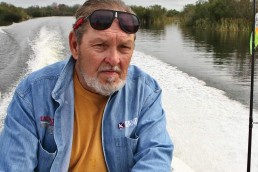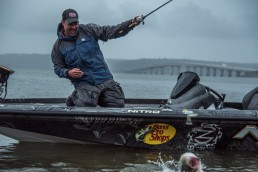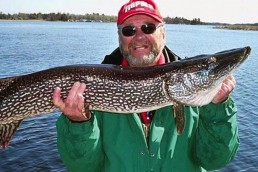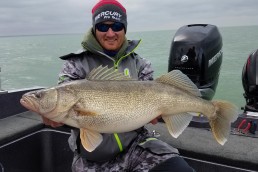Ron Lindner, a Founder of the Modern Fishing Revolution, Passes Away
SHARE THIS POST
Ron Lindner and brother Al came along at an unprecedented time in the history of fishing, when huge change, the likes of which we’ll never see again, was beginning to bubble. Buck Perry offered a set of theories on how fish are influenced by structure, cover, migration routes, and more. Carl Lowrance built a flasher-display sonar unit for small fishing boats.
Waterways were waiting to be studied. Our understanding of how to catch fish was ripe for the explosion that came.
Driven by a gift for fishing theory and the mind of a marketer, Ron put his stamp on the events of the modern fishing revolution. He laughs about how he and Al were like the floating feather seen at the beginning and ending of the movie Forrest Gump. “We just kept ending up where things were happening,” he says with a laugh in his voice.
We would argue that he was less tickled by the feather than perhaps an important force that helped keep it in the air and direct its path with his most profound breaths. The word legend gets tossed around lightly these days, but it fits snugly on Ron Lindner. He and his family have been responsible for Lindy Tackle Company, the Lindy Rig, In-Fisherman Communications Network, Angling Edge Television, and many other things.
In what might have been an ordained trip for the fishing feather, there was time spent guiding and fishing early tournaments in Wisconsin; a move to Brainerd, Minnesota; years spent as a member of the famous Nisswa Guides operating out of Marv Koep’s bait shop; nights at the kitchen table playing with ideas and writing early magazine articles; epiphanies that drove new tackle, approaches to fishing, and new ways of presenting fishing information on television.
These days, he’s at peace with life and his place in it, as one of the patriarchs of perhaps the most influential family in American fishing history. A master of self-deprecation, he seems to revel in stories of his own shortcomings, leaving us to applaud his accomplishments. In the present day, when leapfrogging technology allows newcomers to get up to speed in a fraction of the time it took him to learn to tie the knots, he appreciates the most talented among the current crop of anglers.
In classic Ron fashion, what you get here are brief responses to the actual questions, then magic carpet rides to delightful tangents so worth hearing that you try to stay out of the way and just listen. When his memory calls up what could be a sensitive topic, he declares that he isn’t going there, then, without taking a breath, goes there.
Ron Lindner might be the most curious person in the outdoor business, spending most waking hours wondering what might be next in our understanding of fish, their environments, and how to catch more of them on purpose. Even though he could stay home if he wanted to, his office at Lindner Media Productions has a warm chair on most days he’s around Brainerd. He still wants to be where things are happening, where there are interesting people to talk to about fish and fishing.
He was at the epicenter of it all, he’s one of the great storytellers in our sport, one of the most colorful characters we will ever see, and here we go, with Ron Lindner, in his own words…
MidWest Outdoors: With all the things you have accomplished in fishing, you still love to be part of what’s next. What are you thinking about and working on now?
Ron Lindner: I’m planting trees whose shade I will never sit under. It’s because of all these new things coming in and out, and the way things are shifting. As one example, we tried, to the best of our ability, to get walleye fishing professionalized to the point that it was at a level just below where bass fishing was. It never quite got there, although today there are more walleye tournaments than ever. A lot of them today are partner tournaments, as opposed to the individual hero-type events like the Bassmaster Elites or what FLW has.
We still wanted to do more in the walleye area, so we developed Target Walleye [a free email newsletter and website offering timely walleye fishing information]. Who knows what that will become, but we continue to work on how to best present information from all across the places where walleyes are found.
MWO: You’ve said that you have no life other than fishing, boats, rods, reels, lures, motors, and family. Give us a few details, so we understand how much fishing dominates your life, even to this day.
Lindner: Totally. Totally. Totally. Al, too. My sons, too, and my daughters still work with us as well. And it’s all fishing, all the time. I used to hunt some. We went after a few different things, but I settled at waterfowl. I never quite finished up with the deer thing, but during our school days, when we had Camp Fish, we had a camp up on Lake of the Woods.
MWO: On Obabikon Bay, right?
Lindner: Right, and this was at the time of the bluebills. I remember one time in particular, there were so many bluebills coming in, and I’m in this makeshift blind. Dan Craven yells, “there’s too many of ‘em, fix bayonets, you can’t shoot.” That’s how many birds were around at that time, and even I could hit birds back then. I was doing OK, I was downing a few, but then they went from lead to steel shot and my accuracy rating crashed through the floor. [laughs] I’d get ready and blast away, but nothing would happen in front of me. If you were a dog, you sat by somebody else. [laughs again] Little by little, I started going to Florida to go fishing, instead of farther north to hunt ducks. I started saltwater fishing every winter, maybe about 1990.
MWO: You spend a lot of time every year in Florida, right?
Lindner: Three months minimum. I fish inshore more than offshore. I like offshore, but you’re mainly sitting in a chair in the back of the boat, the captain is up there in a tower, and the mates are around you, and they don’t let you do anything. They set the lines, they see the bite and set the hook, and then hand you the rod and say, “Okay, now you can fight him.” All you are is a winch.
What I really love is fishing the backwaters in a little fishing boat, and catching snook, redfish, sea trout, all those critters. They’re much like the fish we catch here; a lot of times, I take the rods and reels out of my boat here in Minnesota, throw ‘em in my truck, go down and fish with ‘em in Florida, and I haven’t even changed the line yet. Maybe I change from 10-pound leaders to 30-pound leaders. The braided line is still on there, and out we go.
MWO: There will never be another period in fishing history like the one that you and your brother Al not only lived through, but hugely impacted. Did you have a sense, at the time, that it was what it was?
Are you enjoying this post?
You can be among the first to get the latest info on where to go, what to use and how to use it!
Lindner: No, no, no. It was no different than somebody today blundering around and trying things to see if they work. And just a side story: I was talking to a guy at a sports show recently, and he had one of the early [In-Fisherman] magazines, in perfect condition, and he wanted me to sign the cover. Now, Al and I have signed a lot of autographs over the years at shows, and I’ve signed a lot of those covers, but I told the guy, if I had that, I’d package it up in the plastic like it is, and it’s worth a lot more money if I don’t sign it. [laughs] Same thing with a lot of the lures we made; some of ‘em, Al and I made, personally. And we never saved a one. We don’t have any of them. One was the Muskie Mauler.
MWO: I think you showed me a picture of that lure, in an old magazine writeup.
Lindner: Right, it was in Sports Afield, in 1963. And we did a mail-order piece for that. It pre-dated Lindy Tackle. In fact, we called that one Lindner Manufacturing, but that’s another story. That lure was an experiment with doing something that was never done again. These bucktails were run through a machine that would clamp the hairs, then we’d dip ‘em and slide ‘em up on the wire.
MWO: Did clamping them spread the hairs to give the bait more life in the water?
Lindner: No, it closed ‘em all up. It almost worked, but after banging ‘em around and putting the bait in the water, the hairs would swell, and then you’d put it back in your tackle box and they’d contract and they started falling apart. So of that particular lure, I don’t think there were more than about 125 made. It was experimental, but it did go on the market. Lure collectors, like Danny Basore [longtime MidWest Outdoors columnist] go nuts over stuff like this. It was sold through magazines and stores. And it came in a box; it wasn’t like some guy made one in his garage. It was an actual manufactured, catalogued item that went awry and we never made any more. Lindy never made them. I know of two in existence, and only one of them is complete with the actual, original box. I saw another one that had a fake box. It looked like the box, but it wasn’t the box. I looked at it and showed it to Al, and said, “this ain’t it,” and he said, “no, it ain’t,” but the lure was real.
MWO: Give us a sense of what the atmosphere was like during the beginning of what we call the modern fishing revolution, that led to all the new ideas we almost take for granted. How were your fishing principles hatched?
Lindner: It was a time and place that you’re never going to see again. The innovation of the depthfinder, the flasher, and Buck Perry’s theories of structure and fish movement came together at a time when all this stuff became possible. It all started to gain steam in the early ‘60s, and we haven’t looked back since. We’ve been trying to push the envelope every day since then.
More of the story awaits…
There’s plenty more with fishing legend Ron Lindner over on the podcast. You’ll find it in the Podcast section at midwestoutdoors.com. On the home page, look for the button that says Podcast, click on it, and you’ll find the interview. We hope you have time to listen to some of our other episodes as well. We’ll see you there… it’s time well spent.
Lindner Through the Years
1934: Born, Chicago, Ill.
1957: Ron and brother Al Lindner meet Buck Perry at Kline’s sporting goods in Chicago, listen to him talk of structure fishing, fish migration routes, impact of weather on fish, and more. They buy an array of Perry’s famous Spoonplugs and the first Lowrance flasher, the Red Box, a rare product that precedes even the iconic Green Box.
1959: Ron and Al start what eventually became Lindy Tackle Company, calling it the Lindner Lure Company. They made and sold a variety of lures out of their basement in Chicago. Eventually, the most famous tackle item invented by the brothers is added – a hook, line and sinker originally dubbed Lindy’s Rig, that we know as the Lindy Rig. (In 2008, the Minnesota Historical Society included the Lindy Rig in its list of “Minnesota’s 150––the people, places, and things that shape our state.”) Ron’s tackle inventions are many, including the No-Snagg sinker, the stand-up style jighead, the ‘R bend’ for spinnerbaits, the original performance rain suits, and he had a hand in development of the first underwater viewing system.
1969: Started first TV show, Facts of Fishing, with brother Al. Ron wrote the scripts, ran the camera, and worked on production, with Al doing most of the on-camera work. It proved to be a dynamic team that left an indelible mark on outdoor television.
1973: Sold Lindy tackle to Rayovac
1974: Ron and Al, along with legendary fishing educator Bill Binkelman, articulated the F+L+P=S* formula in the first issue of In-Fisherman magazine. Sometimes called “the algebra of fishing,” it’s arguably the most important element of the famous In-Fisherman system. *Fish+Location+Presentation=Success
1988: Inducted as a Legendary Angler into National Fresh Water Fishing Hall of Fame
1998: Sold In-Fisherman to Primedia Broadcasting
2000: Inducted, with Al, into inaugural class of Minnesota Fishing Hall of Fame
2002: Started Angling Edge television series and Lindner Media Productions
2008: Enshrined into National Fresh Water Fishing Hall of Fame
MWO
SHARE THIS POST
Did you enjoy this post?
You can be among the first to get the latest info on where to go, what to use and how to use it!
MWO
We believe being outdoors is good. With more than 1,000 articles each year, MidWest Outdoors magazine is all about sharing outdoor experiences with you—where to go, what to use and how to use it… whether you’re close to home or on that trip of a lifetime.



